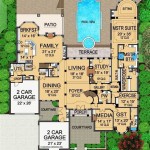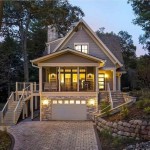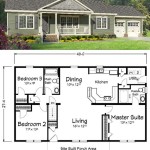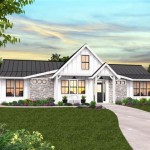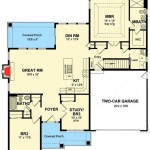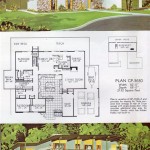Craftsman Style Single Story House Plans: A Detailed Exploration
Craftsman style architecture, with its emphasis on handcrafted details, natural materials, and functional design, remains a popular choice for homeowners seeking a blend of aesthetic appeal and comfortable living. Single-story Craftsman homes, in particular, offer accessibility and convenience, further enhancing their desirability. This article provides a comprehensive overview of Craftsman style single-story house plans, exploring their defining characteristics, advantages, design considerations, and examples of notable features.
Defining Characteristics of Craftsman Style
Craftsman architecture emerged as a reaction against the mass-produced, ornate designs of the Victorian era. The style prioritizes quality craftsmanship, simplicity, and connection to nature. Several key features define Craftsman homes, regardless of their size or layout.
Low-pitched, gabled roofs are a hallmark of Craftsman style. The deep overhanging eaves, often supported by exposed rafters or decorative brackets, provide protection from the elements and contribute to the home's distinctive appearance. Wide front porches, supported by substantial columns, create an inviting entry and offer outdoor living space. These porches frequently extend the length of the facade, emphasizing horizontal lines.
Natural materials are integral to the Craftsman aesthetic. Wood, stone, and brick are commonly used for exterior cladding, creating a warm and textured look. Wood siding, such as clapboard or board and batten, is frequently painted in earthy tones, while stone or brick accents add visual interest and durability. Interior features also incorporate natural materials, with exposed beams, hardwood floors, and built-in cabinetry being common elements.
Emphasis on handcrafted details distinguishes Craftsman homes from more mass-produced styles. These details can include intricate window trim, decorative brackets, custom-built cabinetry, and unique lighting fixtures. These handcrafted elements add character and individuality to the home, reflecting the values of the Arts and Crafts movement. Large, multi-pane windows are another defining feature, allowing ample natural light to flood the interior. These windows are often arranged in geometric patterns and may include stained glass accents.
The interior layout of a Craftsman home often prioritizes functionality and open living spaces. While not always strictly open-concept, there is typically a flow between the living room, dining room, and kitchen. Fireplaces, often made of brick or stone, serve as focal points in the living room. Built-in cabinetry, such as bookshelves and window seats, maximizes space and adds architectural interest.
Advantages of Single-Story Craftsman Homes
Choosing a single-story Craftsman home offers several practical and lifestyle advantages compared to multi-story designs. Accessibility is a primary benefit, eliminating the need for stairs and making the home suitable for individuals of all ages and abilities. This feature is particularly advantageous for families with young children, seniors, or individuals with mobility challenges.
Single-story homes often have a more efficient layout than multi-story homes. All living spaces are located on the same level, reducing the need for hallways and maximizing usable square footage. This can result in a more comfortable and functional living environment. Maintenance is generally easier and less expensive in a single-story home. Exterior upkeep, such as roof repairs and window cleaning, is simplified due to the lack of height. Interior maintenance, such as painting and flooring repairs, is also typically less complicated.
Single-story Craftsman homes are often easier to heat and cool than multi-story homes. Heat rises, so in a multi-story home, the upper levels tend to be warmer than the lower levels. In a single-story home, the temperature is more consistent throughout, reducing energy consumption. The design of a single-story home allows for easier access to the outdoors. Patios, decks, and gardens can be seamlessly integrated with the interior living spaces, creating a cohesive indoor-outdoor living experience. This is particularly appealing in climates with mild weather year-round.
Building a single-story home can sometimes be less expensive than building a similar-sized multi-story home. The simpler foundation and framing requirements can result in cost savings. However, lot size and local building codes can influence the overall cost. Single-story Craftsman homes lend themselves well to aging in place. The accessibility features and simplified maintenance make them suitable for individuals who plan to remain in their homes as they age.
Key Design Considerations for Single-Story Craftsman Plans
When designing or selecting a single-story Craftsman house plan, several key considerations should be taken into account to ensure the home meets the homeowner's needs and preferences. Lot size and orientation are critical factors. The size and shape of the lot will influence the overall footprint of the home and its placement on the property. The orientation of the lot will affect the amount of natural light the home receives and the energy efficiency of the design.
Careful planning is essential for maximizing space and creating a functional layout. Consider the flow between different living areas, the placement of bedrooms and bathrooms, and the amount of storage space needed. Open-concept layouts can create a sense of spaciousness, while strategically placed walls and partitions can define different zones within the home. Natural light is a defining characteristic of Craftsman style, so it is important to incorporate ample windows and skylights into the design. Consider the placement of windows to maximize daylight while minimizing glare and heat gain. Skylights can be particularly useful in areas where natural light is limited, such as hallways and bathrooms.
Selecting appropriate materials and finishes is essential for achieving the desired Craftsman aesthetic. Choose natural materials such as wood, stone, and brick for the exterior and interior. Pay attention to the details, such as the type of siding, the color of the paint, and the style of the windows and doors. Interior finishes should complement the exterior design and reflect the Craftsman style. Consider hardwood floors, exposed beams, built-in cabinetry, and handcrafted lighting fixtures. A well-designed landscape can enhance the curb appeal of a single-story Craftsman home. Plant native trees and shrubs, create inviting walkways, and incorporate outdoor living spaces such as patios and decks. The landscape should complement the architecture of the home and create a sense of connection to nature.
Consider the long-term maintenance requirements of the home when selecting materials and finishes. Choose durable and low-maintenance options that will withstand the elements and require minimal upkeep. Proper insulation is essential for energy efficiency and comfort. Ensure the home is adequately insulated in the walls, roof, and floors to reduce heating and cooling costs. Consider incorporating sustainable design features into the home, such as solar panels, rainwater harvesting systems, and energy-efficient appliances. These features can reduce the home's environmental impact and lower utility bills.
Universal design principles can be incorporated into a single-story Craftsman home to make it accessible and adaptable for individuals of all ages and abilities. These principles include features such as wider doorways, level thresholds, grab bars in bathrooms, and adjustable-height countertops. Consider the resale value of the home when making design decisions. A well-designed and well-maintained single-story Craftsman home is likely to retain its value over time and appeal to a wide range of buyers.
Examples of Notable Features in Single-Story Craftsman Homes
Several features frequently appear in single-story Craftsman house plans, adding to their character and functionality. Built-in features are a hallmark of Craftsman style. These often include bookshelves, window seats, fireplaces with built-in mantels, and dining room hutches. These built-ins maximize space and add architectural interest. Exposed beams add a rustic and architectural element to the interior. They are often used in living rooms, dining rooms, and kitchens, creating a sense of warmth and character. Fireplaces, often made of brick or stone, serve as focal points in the living room. They typically feature a substantial mantel and may include decorative details such as tile or carvings.
Generous porches are another defining feature of Craftsman homes. They provide an inviting entry and offer outdoor living space. Porches may be covered or screened, allowing for year-round use. Window seats provide a cozy and comfortable space for reading or relaxing. They are often located in living rooms, bedrooms, or hallways. Stained glass windows can add a touch of color and artistry to the home. They are often used in entryways, bathrooms, or living rooms. Hardwood floors are a classic choice for Craftsman homes. They add warmth and character to the interior. Exposed ductwork, while less common, can add an industrial-chic touch to a Craftsman home. It is often used in basements or loft spaces.
Arched doorways can add a touch of elegance and sophistication to the interior. They are often used in entryways or between living spaces. Penny tile flooring is a popular choice for bathrooms in Craftsman homes. It adds a vintage touch and is durable and easy to clean. Wainscoting, which is wood paneling that covers the lower portion of a wall, can add architectural interest to the interior. It is often used in dining rooms, hallways, or bathrooms. Natural stone accents, such as stone veneer on the exterior or stone fireplaces, add texture and visual interest to the home. Craftsman-style lighting fixtures, such as pendant lights, sconces, and chandeliers, can enhance the overall aesthetic of the home. They often feature handcrafted details and natural materials.
:max_bytes(150000):strip_icc()/SL-1444_FCR-6feba1b011944212b854a6aabde38158.jpg?strip=all)
These One Story Craftsman House Plans Are Full Of Southern Charm

Craftsman Style House Plans Big And Small Houseplans Blog Com

One Story Craftsman Style House Plan 7069 Covington

House Plan 7806 00013 Bungalow 1 199 Square Feet 3 Bedrooms 2 Bathrooms Craftsman Bungalows Plans

Single Story Craftsman Home Plans Blog Eplans Com

Craftsman Style House Plan 3 Beds 2 Baths 1749 Sq Ft 434 17 Houseplans Com

Craftsman Style House Plans Sater Design Collection

Craftsman House Plans Style Home The Designers

Durham Drive Craftsman House Plans Ranch

Craftsman Bungalow House Plans Company

